Astronomers Find New Mysterious Moons in Our Solar System Every Year. These Are The Weirdest.
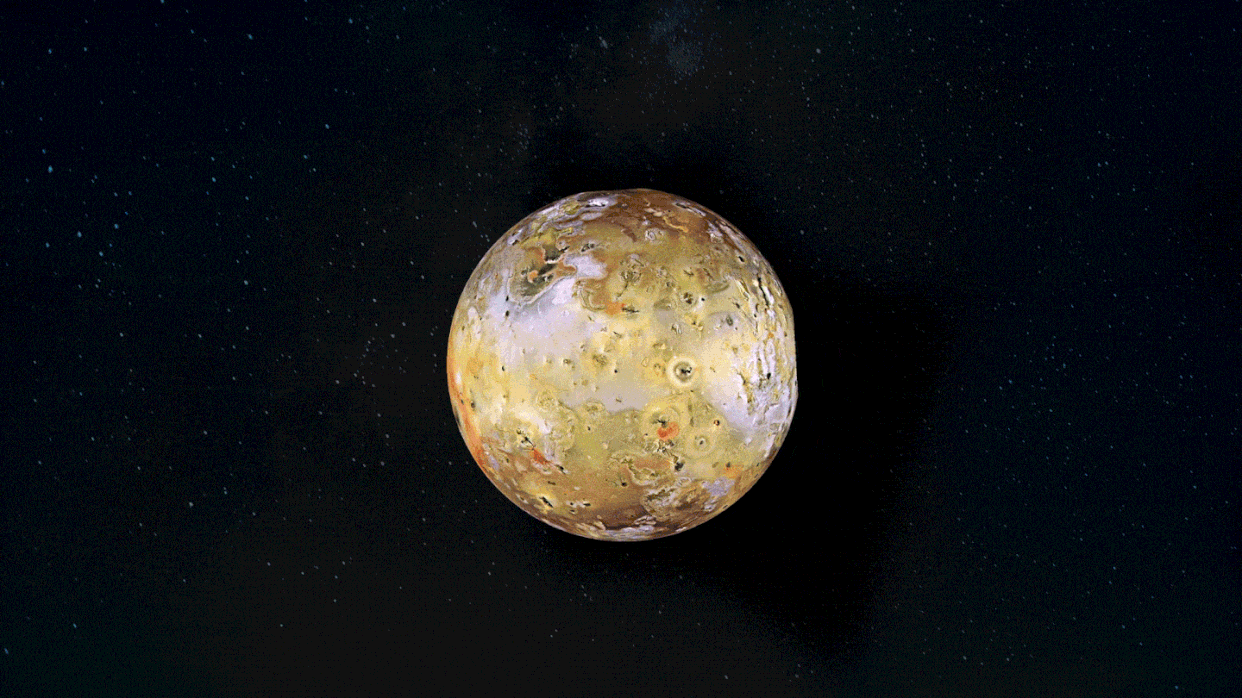
Around 4.5 billion years ago, our solar system emerged from a violent cloud of gas and dust. That dust and gas collapsed, forming a spinning disk of interstellar material which, perhaps jolted by the shockwave of a nearby supernova, created the sun, the planets, and, of course, their moons.
These natural satellites orbit and often influence their respective planets (and dwarf planets) in curious ways. In some cases, they are globs of rubble, commandeered by the orbits of planets they drew too close to. Others, like our own moon, are remnants from the primeval collisions of ancient objects. Ours was the “first” moon. Early civilizations clocked its myriad changes—its changing shape, its periodic absence, the wonder of its eclipses.
Galileo Galilei’s subsequent discovery of Io, Europa, Ganymede, and Callisto in the 17th century restructured our understanding of the universe. Over the years, we’ve constructed ever-more powerful telescopes and lofted endeavoring spacecraft toward the stars, cueing an unending trickle of fascinating lunar discoveries.
According to NASA's website, there are 293 confirmed moons in the solar system. We’re highlighting our top 30 favorite moons here. This whimsical ranking, which we initially conceived of in 2019 and have since updated, is completely subjective and, if we’re being honest, based almost entirely on how cool we think each moon is. We did speak to nearly two dozen scientists, all of whom waxed poetic about the moons that fascinate them. As humanity’s ability to study the cosmos becomes more sophisticated, we’ll certainly identify more moons orbiting distant planets, and rank them accordingly.
You may agree. You may disagree. Or, keeping good company with one famous astronomer, you may wonder why in the hell we’d take on such a task in the first place: “Do you really need to rank them all? There are hundreds.” Whatever your stance, we hope you come away with a hearty appreciation for our solar system’s strangest objects.
Moon Movement
Moons are far from simple celestial objects, so before we dive in, here are a few helpful definitions to guide you along your cosmic journey.
Prograde
A moon that orbits its object in the same direction as that object's rotation.
Retrograde
A moon that orbits its object in the opposite direction of that object's rotation.
Regular
These moons have relatively small orbits, which are often circular and roughly hover along the parent object's equatorial plane. These moons likely formed alongside their parent body, accreting material as they zipped along their early orbits.
Irregular
Irregular moons often have large, eccentric orbits that don't neatly circle the object's equator. Most irregular moons are thought to be "captured," meaning that got tangled up in the orbits of the larger body and stayed there.
Eccentricity
Objects with a more circular orbit have an eccentricity closer to 0.0. Objects with a more elliptical orbit have an eccentricity closer to 1.0.

1. Titan
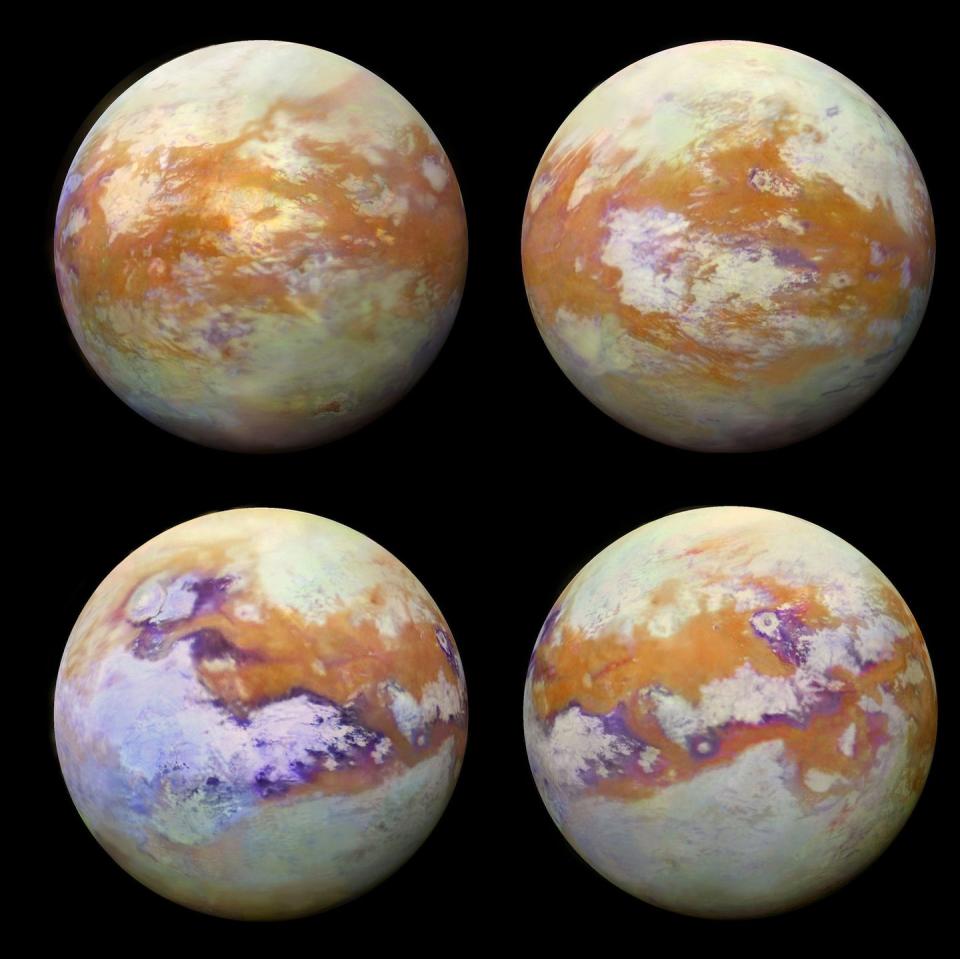
On January 14, 2005, the tiny Huygens probe—an integral facet of NASA’s Cassini mission—floated down through a thick haze and onto a sandy riverbed on the surface of Saturn’s largest moon. Footage from the landing sequence revealed a sepia-toned world not unlike our own.
“[Titan] is the only moon with a thick, significant atmosphere, and the surface pressure is 50 percent higher than the surface pressure on Earth,” Peter Gao, PhD, a staff scientist at Carnegie Science, says. While you would definitely need an oxygen mask and a heater, you could hypothetically walk around on the moon’s surface without a pressurized suit.
Titan’s atmosphere is flush with nitrogen, just like Earth’s. But instead of oxygen, the second most abundant element in the moon’s atmosphere is methane. Ultraviolet light from the sun breaks down that methane and nitrogen, forming the goopy haze that surrounds the moon, Gao says. “That’s why it looks orange.” The evaporation of methane and ethane molecules near Titan’s surface generates powerful dust storms comparable to those on Earth and Mars.
The moon’s surface is dominated by hydrocarbons, highly combustible organic compounds, like methane and ethane. Just as we find all three phases of water on Earth—solid, liquid, and gas—you can find all three phases of methane on Titan.
Aside from Earth, it is the only known celestial body to have liquid on its surface. (Other worlds have subsurface oceans.) “It looks hauntingly familiar,” says Linda Spilker, PhD, a planetary scientist at NASA’s Jet Propulsion Laboratory. But unlike Earth’s rivers, lakes, and seas, Titan’s are filled with hydrocarbons. The amount of liquid hydrocarbons found in these lakes and streams is hundreds of times greater than all of Earth’s oil and natural gas reserves.
Instead of sandstone or granite, the bedrock on Titan, which forms jutting mountains and large mesas, is made from water ice. Titan is also home to a vast network of dune fields made mostly of water ice and dark, hydrocarbon grains which, NASA suggests, resemble coffee grounds. As if that weren’t enough, planetary scientists believe that a vast subsurface ocean rests beneath all of these features.
Scientists aren't sure conditions on Titan could support life, but the bizarre world remains a prime target for future exploration. In 2028, NASA plans to launch the Dragonfly mission, a rotorcraft that will hopscotch to different regions on Titan’s surface, collecting data so that we can better understand this mysterious moon.
2. Io

Io, the third-largest moon of Jupiter, is the most volcanically active body in the solar system. “The eruptions are so big that we can actually see them from telescopes based on Earth,” says Dan Spencer, formerly a PhD student at the University of Oxford. “If Io swapped places with our moon, you’d be able to see eruptions with the naked eye.” When astronomers recently mapped the violent world, they counted at least 250 active volcanoes on its surface. Some of these volcanoes spew jets of lava dozens of miles high.
So, why is the moon so volcanically active? We have gravity to thank. Io is smack-dab in the middle of a gravitational game of tug-of-war. Io’s the recipient of an intense pull from the strong gravitational field of Jupiter as well as the gravitational fields of the neighboring Ganymede and Europa. Io is also subjected to powerful tidal forces. Its surface bubbles and bulges, sometimes by as much as 330 feet, generating a tremendous amount of heat and friction within the moon.
Its thin, noxious atmosphere is almost completely composed of sulfur-dioxide gas, some of which condenses into sulfur-dioxide ice when it passes through Jupiter’s shadow.
Because it is the closest Galilean moon to Jupiter and passes through the planet’s magnetic field, Io can also generate a serious electric current—around 3 million amperes. This jolt of electricity is shot back toward Jupiter and generates lightning in the planet’s upper atmosphere. As Io sweeps by Jupiter, the planet drags sulfur-dioxide particles off its surface, forming a ring of ionized plasma around the planet.
It’s unlikely we’d ever find life on Io. Despite this, planetary scientists hope to learn more about Earth’s own volcanic past by studying Io. Researchers have long proposed to send a probe to take a closer look at its lava flows, which are stitched together like a psychedelic patchwork quilt.
For space physicist Xianzhe Jia, PhD, of the University of Michigan, the allure of the moon is simple: “It looks colorful.”
3. Enceladus
Saturn’s tiny 310-mile-wide moon, Enceladus, didn’t look like much at first. “We thought it would be frozen solid,” says Spilker. “And yet, over the course of the 13 years of the Cassini mission, [we] discovered that it had a global ocean of liquid water, it has jets coming out of the south pole, and evidence for hydrothermal vents.” This subsurface ocean makes it a prime target in the search for life.
Scientists were so intrigued by the moon’s jets that they sent Cassini on a detour to investigate. It sailed through the icy plumes multiple times and made unbelievable discoveries. Spilker says the craft found hydrogen, carbon, nitrogen, and oxygen in the plume—the “Big Four” ingredients of life. It also clocked salt, silica grains, and strange nanocarbons that form at high temperatures, suggesting the sea floor could be dotted with hydrothermal vents. The recent discovery of phosphorus in the icy plumes—a first-time find for any alien ocean—further suggests the moon could be habitable.
The plumes spew this material into space; some of it floats off to seed Saturn’s rings, and some—mostly water vapor—even drift into Saturn’s atmosphere. (Enceladus, according to NASA, is the only moon found to affect its parent planet’s chemistry.) Most of it, however, falls back down to the moon’s surface. Spilker says a sample mission could be as simple as landing beneath a plume, opening up a sample collector, and then jetting back to Earth. “Go to Enceladus. Just peek down, and see if there’s life in there—or see if there’s potential for life in there,” Fredrik Johansson, PhD, of the Swedish Institute of Space Physics says with a grin. “You don’t have to dig!”
“We had so many clues,” Spilker said of Voyager 2’s flyby of the tiger-striped moon in 1981. “But it took Cassini to go back and figure it out.” In an almost poetic twist, the moon is also the most reflective body in the solar system—reflecting almost 100 percent of the light that reaches it. It is a beacon in more ways than one.
4. Triton

Triton, the largest moon of Neptune, is an interloper. Planetary scientists believe the moon originated far from its parent planet, in the distant Kuiper Belt, and was later sucked into Neptune’s orbit. “It’s really cool to think that there’s basically a captured Pluto orbiting Neptune,” atmospheric scientist David Brain, PhD, of the University of Colorado, Boulder, says of the roughly 1,600-mile-wide moon. Of all the large moons in the solar system, it’s also the only one to orbit in the opposite direction of its planet—a likely remnant of its capture.
Dense Triton is rockier than the other satellites that circle the outer planets. “We think it might have an ocean underneath its icy surface on top of where there’s a rocky core,” says space and planetary scientist Adam Masters, PhD, of Imperial College London. “Triton stands out as quite unique in that respect.”
The moon is frigid. When Voyager 2 zipped past Neptune and Triton, it took surface-temperature readings, which revealed that the moon’s surface could drop to around -391 degrees Fahrenheit. Planetary scientists believe ammonia may be the key to keeping its hidden ocean liquid in spite of the freezing temperatures.
Triton’s shining, ice-covered surface reflects 70 percent of the light that it receives, according to NASA, and its thin, nitrogen-rich atmosphere has traces of methane, an indicator that it might be more alive—geologically speaking—than previously thought.
5. Europa
In 2012, the Hubble Space Telescope snapped pictures of Europa that suggested it may have massive plumes of water vapor jetting as high as 100 miles into space. Scientists were stunned to find potential evidence for liquid water. Inspired by Hubble’s find, scientists revisited old Galileo mission data and found similar evidence for plumes of water vapor, increasing the odds that the moon might host—at the very least—the ingredients for life.
Europa is covered in a thick crust of ice, the surface of which is plastered with lineae, a tangled network of salt-encrusted gashes thought to have formed by tidal forces. There’s also a series of surface features called “chaos terrain,” which are thought to be regions where blocky chunks of sulfur and salt-stained crust, initially laid upon buried lakes, have subsided. It doesn’t get more badass than that.
Beneath that crust, scientists believe there’s a vast saltwater ocean, nestled atop a rocky mantle and iron core. That ocean contains more water than all of Earth’s oceans, explains planetary scientist Christopher Edwards, PhD, of Northern Arizona University. Researchers have proposed sending a submersible that would drill down through the moon’s thick crust—perhaps slipping into one of these canyons—to explore the ocean beneath.
“I think [Europa]’s got the highest probability of hosting some alien life in our solar system that we could go and find out if it’s there,” says former NASA astronaut John Grunsfeld, PhD. “We’re going to do that hopefully with Europa Clipper or some other missions.”
NASA’s Europa Clipper mission is set to launch for the frozen moon in October 2024. Once it arrives at Europa (after a six-year journey), the spacecraft will conduct nearly 50 flybys. Its array of scientific instruments will snap pictures and capture spectra and thermal images of this geologically active moon—all in an effort to more closely identify its most active regions.
We can’t wait to see what it finds.
6. Ganymede
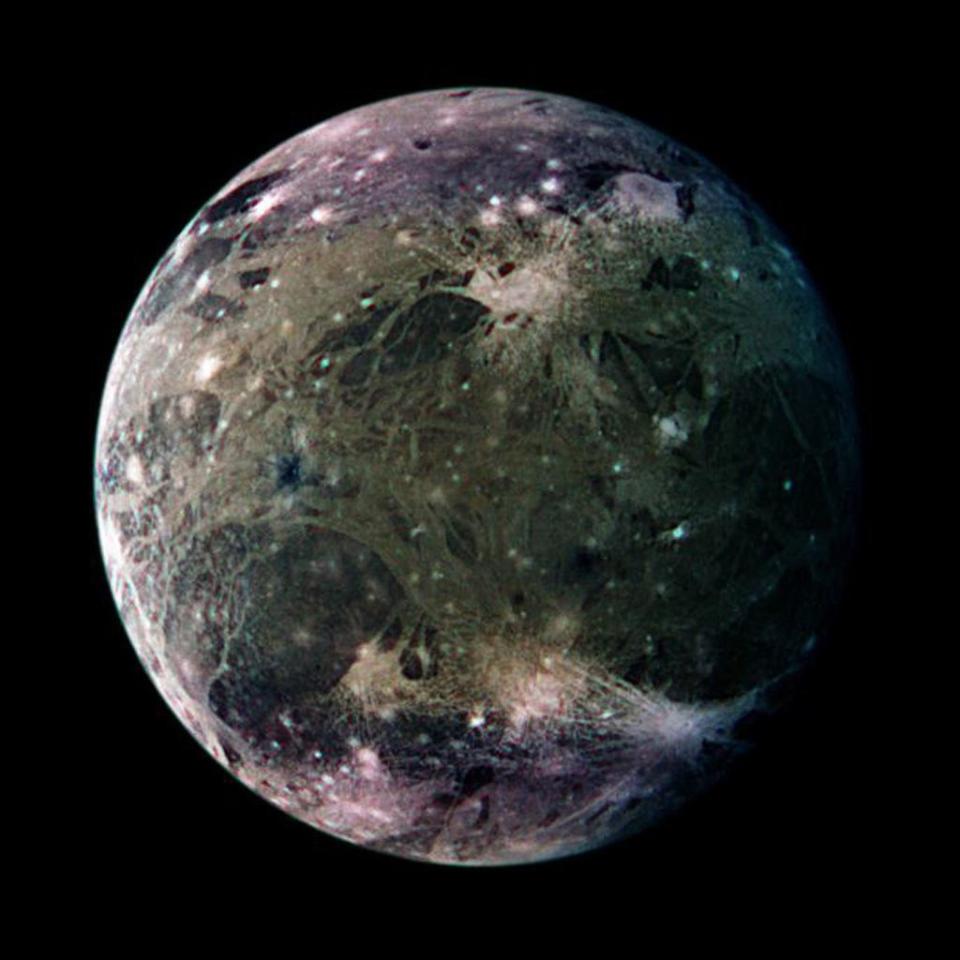
“It’s definitely the most underrated moon in the solar system,” says Jacob Abrahams, PhD, a former member of the Europa Clipper team at NASA’s Jet Propulsion Laboratory. Jupiter’s Ganymede is also the largest in our solar system—it’s larger than Mercury—and likely has a vast ocean of salty water beneath its crust.
“It’s the only moon we’ve known yet which has its own magnetic field, and we don’t know why, really,” space scientist Glyn Collinson, PhD, of NASA’s Goddard Space Flight Center says. “Basically all of our physics and understanding breaks down, and everybody’s models go wrong, and everybody ends up yelling at each other.”
Scientists have long suspected that the moon may have a metallic iron core. In 2015, the Hubble Space Telescope spotted ribbons of aurorae circling the moon—a discovery that surprised researchers.
We may soon get a closer look at the curious world. In April 2023, the European Space Agency launched the Jupiter Icy Moons Explorer (Juice) mission, which will explore Europa, Callisto, and, of course, Ganymede. “We get to explore this thing and we have no idea how it works,” Collinson says. “It confounds us at every turn.”
🌘 SO...WHAT IS A MOON, ANYWAY?
Most experts agree that a moon is simply defined as an object that orbits another celestial body. These satellites come in a variety of shapes and sizes—some are large and rounded by the enormity of their gravity, while others are tiny, lumpy, and pockmarked rocks.
Astronomers have also discovered quasi-moons, which orbit the sun alongside larger objects. Earth currently has an estimated seven quasi-moons—one of which, Kamo‘oalewa, is thought to be a chunk of the moon. Occasionally, Earth will even capture mini-moons, or tiny asteroids that are gravitationally bound to Earth for a time but eventually fly off into space.
7. Iapetus

“I think Iapetus might be the most interesting [moon],” says planetary scientist Scott Sheppard, PhD, of Carnegie Science.
The unique coloration of Saturn’s third-largest moon—one side of the moon is covered in a massive splotch of dark material, while the other is a pristine shade of white—is somewhat of a mystery to researchers.
“We think Iapetus is like a snowplow,” Sheppard says. Because the moon is tidally locked with Saturn, the same hemisphere is always facing the forward direction as it moves through its orbit. This means the leading face naturally picks up more orbital debris than the other. One theory suggests Iapetus is plastered with the dust of another Saturnian moon, Phoebe. When the pockmarked satellite sheds material, that debris lands on
Iapetus’s leading edge.
The moon is also home to a towering equatorial ridge. “There’s some thought that maybe Iapetus had a ring, and as the ring collapsed onto the surface, it created—a long time ago—this mountain range,” says Spilker. Others have suggested that the mountains arose when the moon was first forming and spinning much faster, and thus shoving material toward the equator.
Sheppard is perhaps most intrigued by its strange inclination. Most of Saturn’s regular moons, the ones that formed along with it, orbit along the same plane. But Iapetus’s orbit lies about eight degrees outside that plane. “That suggests that Iapetus may not have formed with Saturn,” Sheppard says. “Maybe it is a captured moon.”
8. Moon Moon (Our Moon)
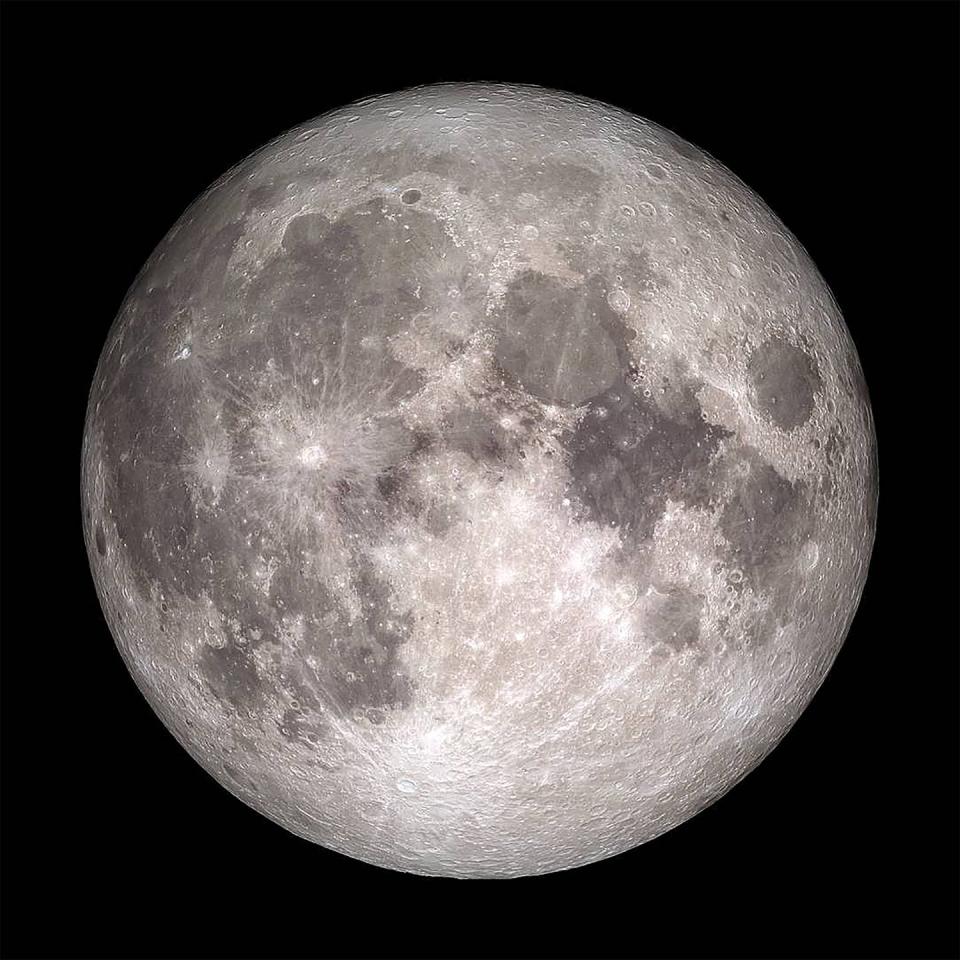
“I can’t tell you how many times I was a little kid driving back from my grandmother’s house in Chicago to the South Side of Chicago, looking out the window and staring at the moon,” Grunsfeld says. “Everybody has their own personal view, and I have to start with our moon because it’s our moon.”
Since the dawn of time, humanity has been transfixed with our closest planetary neighbor. That gray rock, suspended in the night sky, has inspired generations of artists, poets, and explorers. Like so many other astronauts, Grunsfeld credits the lunar landing for inspiring an early interest in science. “Didn’t get there, but I got to Hubble three times, so that’s not too bad,” he says.
Formed billions of years ago after a Mars-sized body slammed into Earth, the moon sways Earth’s tides and stabilizes Earth’s wobble on its axis, securing a livable climate. It influences the length of our days, and its light serves as a cue for animal behaviors like spawning and migration. There’s even been evidence to suggest its tidal forces affect seismic activity on Earth.
Channeling my mother: "But we have a perfectly good moon right here at home!"
— James Urton (he/him) 🏳️🌈 (@jamesurton) December 12, 2019
“It’s close enough that you can see its surface and identify craters, mountain ranges, rilles, valleys, escarpments, and other features,” explains Bing Quock, assistant director of the Morrison Planetarium at the California Academy of Sciences in San Francisco. This opportunity allows scientists to explore some of the moon’s most intriguing features like the Lunar X or the chains of craters on its surface. It’s one of just a few surfaces in the solar system that generates an electrostatic charge.
“In the permanently shadowed regions near the poles are some of the coldest temperatures recorded anywhere in the solar system,” says planetary scientist Rebecca Ghent, PhD, of the Planetary Science Institute. Orbiting spacecraft have discovered water ice—a valuable resource we’ll tap into if we aim to explore distant reaches of the solar system.
And, of course, we’ve been there. We’ve launched over 100 missions to the moon, and 12 astronauts have set foot there. We’ve walked, skipped, and stumbled across its surface, planted flags and carved donuts into the lunar regolith. We’ve studied hundreds of pounds
of geologic samples we retrieved, detailing every grain with care. “Still gives me chills just to think about it,” Quock says.
Finally, our excursions to the moon have allowed us a unique look at our own home. It’s been dubbed “the Overview Effect,” and a number of astronauts have shared how looking back at Earth from the moon has shaped their perspective upon returning home. “Just as valuable as what we learned about the moon during [the Apollo] missions was the sobering perspective gained about Earth as a fragile, delicate oasis of life in the unimaginable emptiness of space,” Quock says.
We’ll be going back soon. NASA aims to land the first woman and first person of color on the moon by 2026. China is also planning to send astronauts to the lunar surface within the decade. There’s no doubt that when we eventually do return to the moon, a whole new world will be waiting for us.
9. Charon
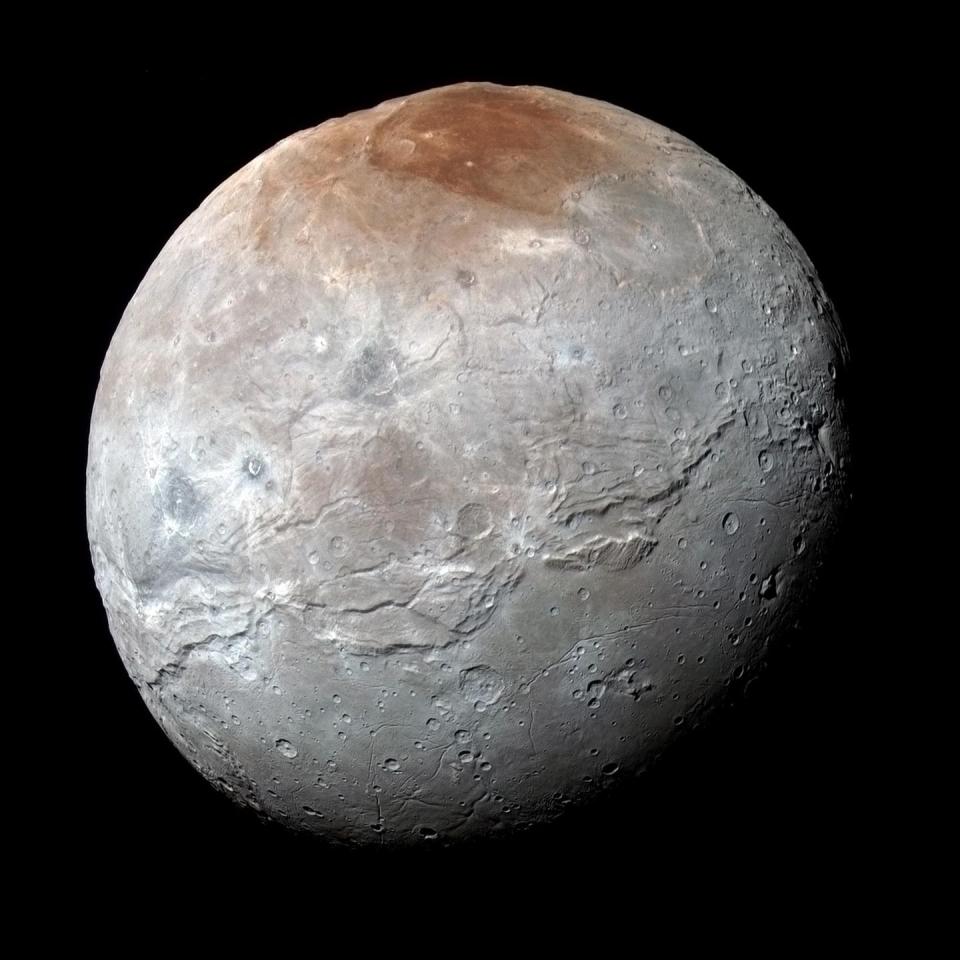
Charon’s orbit is completely unique to the solar system. The moon and its parent, Pluto, are part of what’s called a double planetary system, meaning they both orbit the same point, an entirely separate center of mass. They’re also mutually tidally locked, which means if you were standing on Pluto, you’d see the same face of Charon hanging in the same spot in the sky. In other words, it never sets.
“Charon has this really dark cap of material,” says Jack Conrad, PhD, a planetary scientist at the Planetary Science Institute. That blood-red dusting is made up of an organic compound called tholins, which forms from methane.
One theory is that Pluto might have ejected atmospheric methane onto the moon. Another theory suggests that cryovolcanoes along the moon’s surface belch out methane, which then drifts to the north pole, freezes, and falls to the surface. The sun’s UV rays spark a chemical reaction that converts the colorless methane ice into red tholins.
One thing is certain: The moon has a violent past. “Charon seems to have just ripped itself asunder,” Conrad says. A 1,000-mile-long canyon tears across Charon’s southern hemisphere and the moon has a towering mountain, which juts out of a deep hole on its surface.
10. Dimorphos (Formerly Known as Didymoon)
“It’s tiny and it’s orbiting an asteroid! How can you not like something like that?” says Charlotte Götz, PhD, a lecturer in physics at Northumbria University in England.
At 525 feet in diameter, Dimorphos, which orbits the asteroid Didymos, is slightly larger than one of the great pyramids in Egypt. The small moon is one of the solar system’s quaintest features, but it’ll take part in what is arguably one of the most important space missions of all time.
Didymos and Dimorphos are the target of an ongoing international collaboration to test one of humanity’s most daring plans: deflecting a potentially hazardous object that could strike Earth. In 2022, an intrepid NASA spacecraft—dubbed Double Asteroid Redirection Test, or DART—flung itself into the small moon in an attempt to knock it off course. Preliminary results of the collision revealed the spacecraft successfully shifted the asteroid’s trajectory.
A follow-up craft operated by the European Space Agency, called Hera, is set to launch in October 2024. It will continue to measure the impact’s aftermath and report back to scientists.
11. Miranda
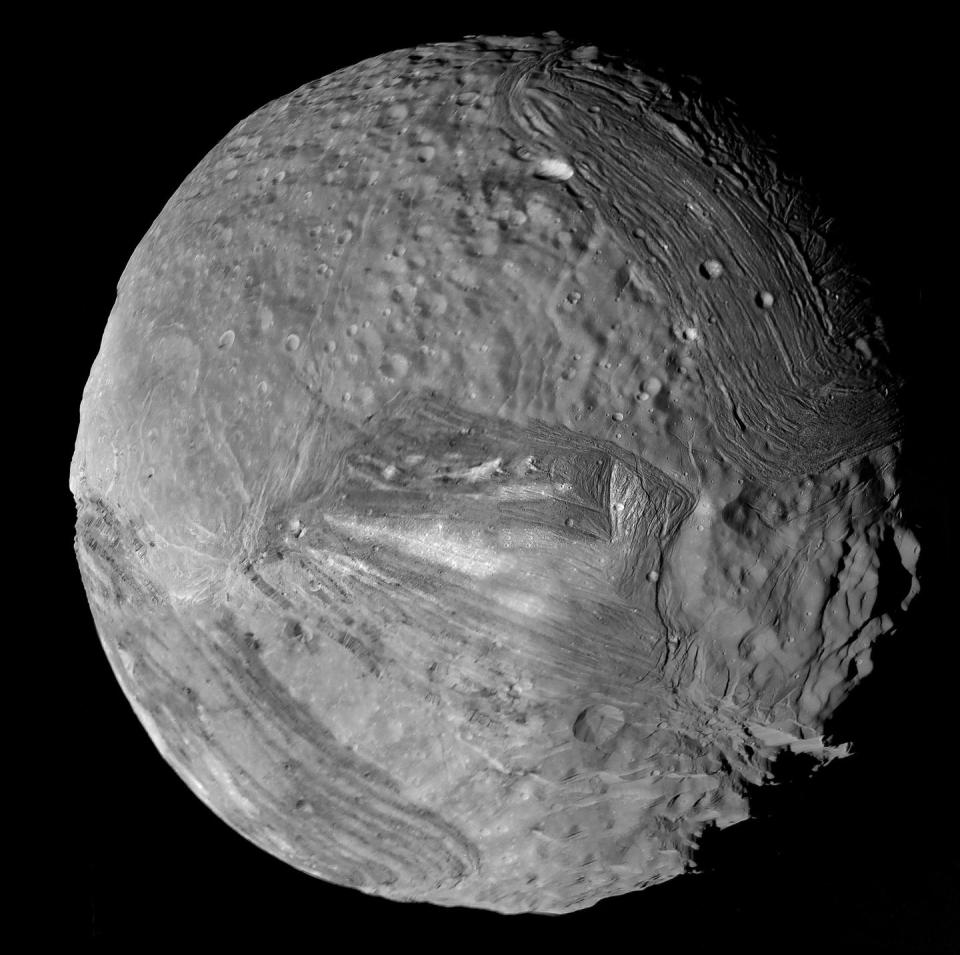
Uranus's Frankensteinian moon Miranda looks like it’s been torn apart and stitched back together a thousand times. Miranda, the innermost of the planet's five major moons, has a bizarre surface.
The moon’s southern hemisphere is marked by “coronae,” a trio of crater-free patches composed of ridges and valleys. Researchers aren’t sure how Miranda’s splintered surface formed. One theory suggests the moon was split open by a massive impact and then quickly pulled back together. Some researchers suspect the moon’s early, more eccentric orbit may have generated strong tidal forces as it swept close to Uranus. This tidal influence could have deformed the moon’s interior, causing it to heat up and kick-start a period of tectonic activity.
Conservative estimates suggest the transparent face of Verona Rupes—thought to be the solar system’s tallest cliff—could drop at least 33,000 feet, or five times the depth of the Grand Canyon. “If you stepped off the cliff, you’d have time to read the newspaper on the way down,” Spilker says of the roughly 10-minute-long fall.
“All these satellites, particularly the ones far away and small, are surprising us,” says planetary scientist Mark Hofstadter, PhD, of NASA’s Jet Propulsion Laboratory. Miranda is certainly no exception.
12. Daphnis
Daphnis zips around Saturn, tucked in a gap at the edge of one of the planet’s rings. The gravitational pull of the tiny, dynamic rock tugs at dust particles along the edge of the gap, carving waves of material that both lead and trail the moon. During Saturn’s equinox, when the plane of the planet’s rings aligns with the sun, these tiny perturbations cast mesmerizing shadows.
13. Phobos and 14. Deimos
The Martian moon Phobos, roughly 17 miles across, is marred by the massive Stickney crater, which takes up almost half of its surface.
The rubbly moon can “fall apart due to stress at any time—I relate to that as a grad student,” says Gwen Hanley, PhD, who was at the time of this interview a grad student at the University of California, Berkeley. (Hanley, now a staff researcher at Berkeley’s Space Sciences Lab, did not fall apart due to stress and has since completed her doctoral degree.)
It also has a decaying orbit, which means Mars tugs on the doomed moon, drawing it closer—as much as seven-tenths of an inch per year, by some estimates. Eventually, astronomers believe Phobos will either be torn to bits, forming a ring around Mars, or potentially smash into the Red Planet. Deimos, on the other hand, is slowly scooting away from the planet. Astronomers believe its outwardly decaying orbit will eventually fling the 9-mile-wide moon into space.
I love them all. Except Deimos. I think it’s important to arbitrarily pick a villain.
— Mark Panning (@MarkPanning) December 12, 2019
Thanks to a quirk of orbital mechanics, the moons put on a compelling display in the Martian sky. “If you’re standing on the surface of Mars looking up at the moons, it looks like they’re moving in different directions,” says Brain. Due to its close proximity, Phobos orbits Mars faster than the planet rotates. Deimos, on the other hand, is farther away and orbits Mars more slowly than the planet rotates.
Their origin is a mystery. Both moons have a nearly circular orbit, suggesting they may have formed near the Red Planet, possibly the result of a massive Martian asteroid impact that shed debris. Others, though, have theorized that these could potentially be captured asteroids. They may not have formed the same way at all. Fortunately, scientists may soon gain a clearer view of their perplexing origins.
Japan’s space agency, JAXA, plans to launch a mission to investigate the pair in 2026. The Martian Moons eXploration mission will attempt to bring samples of Phobos back to Earth. “There should be a few percent Mars material on the surface of Phobos, so it’s sort of like our first Mars sample return,” says astromaterials curator Francis McCubbin, PhD, of NASA’s Johnson Space Center.
🌒 WAIT A SECOND... WHY DON'T MERCURY AND VENUS HAVE MOONS?
Mercury is simply too close to the sun. While researchers believe that Mercury may have experienced a colossal impact that flung material into space, its orbit isn’t strong enough to hold on to that debris.
As for Venus, one theory is that the planet never experienced a significant moon-forming impact. Another theory suggests the planet has undergone two separate collisions: The first collision likely formed a moon, while the second collision reversed Venus’s direction of rotation, disrupting the moon’s orbit enough to send the satellite hurtling into the planet.
Venus does have a tiny quasi-moon named Zoozve, which occupies a strange orbit around Venus and the sun.
15. Mimas

"That's no moon!"
Obi-Wan Kenobi was right about the Death Star. This celestial object, however, is a moon.
Mimas, one of Saturn’s many moons, is best known for Herschel crater, which sci-fi buffs will attest makes the moon look like a dollar-store version of the Death Star. The real mystery? How it survived such an impact without breaking apart.
16. Tethys
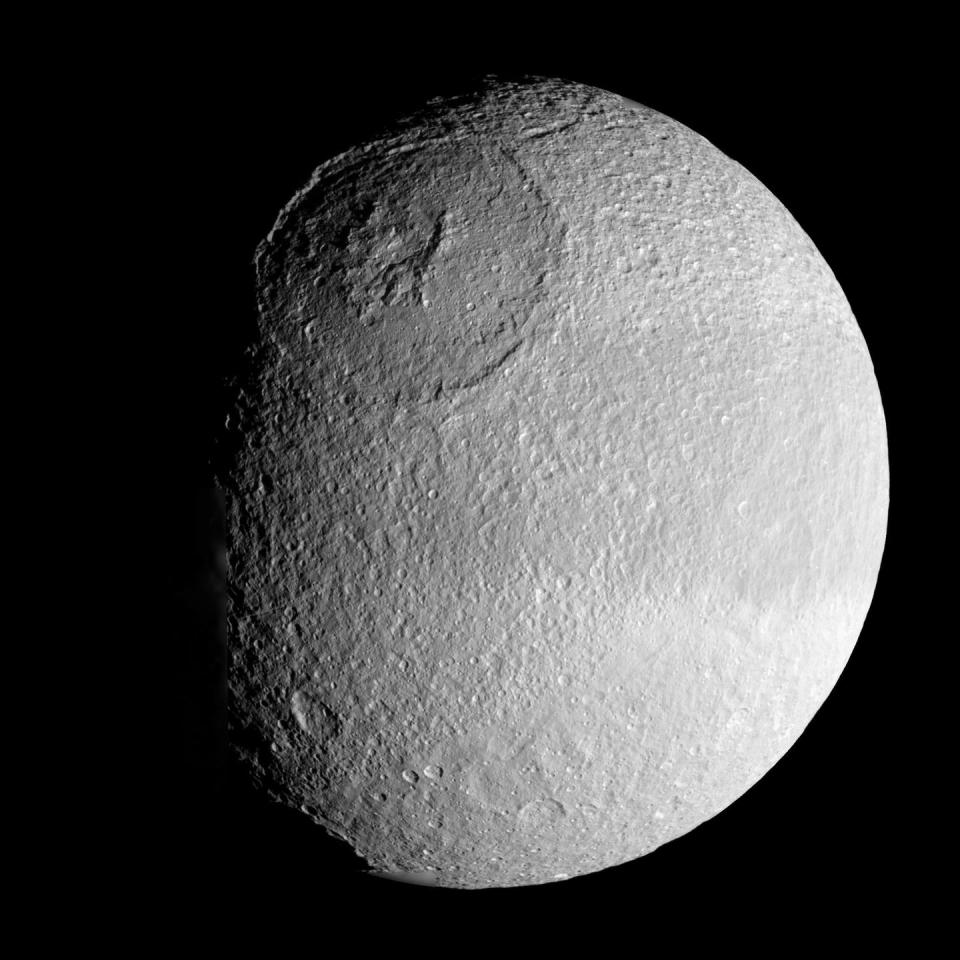
“Let’s give a shout-out to Tethys, the moon that’s made of pure water,” Kevin Zahnle, PhD, a researcher at NASA’s Ames Research Center, says of the Saturnian moon.“It’s like a teardrop in space. Sorry—a frozen teardrop in space.”
One of Tethys’s strangest surface features is a set of red-hued arcs that scientists suspect are caused by chemical impurities in the ice.
17. Dactyl
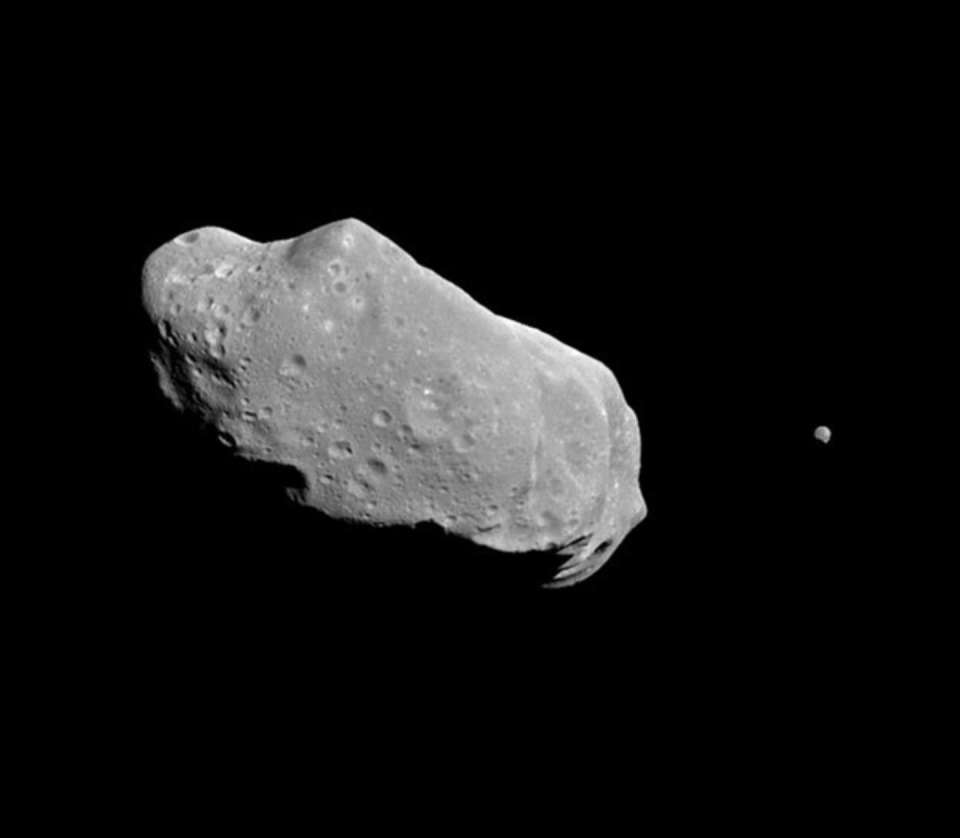
Dactyl stunned the world when astronomers discovered it in 1994. It was the first moon to be observed and photographed orbiting an asteroid. For that reason alone, we’ll always love it.
18. Atlas and 19. Pan
Atlas and Pan are just two tiny ravioli whizzing through space.
Why do these small moons look like pasta? As they zip through their respective gaps in Saturn’s rings, they scoop up material, which, thanks to rotational forces, slides toward the equator.
20. Callisto

Scientists believe, Callisto, the moon of Jupiter has the oldest and most cratered surface in our planetary neighborhood. Estimates suggest it’s about four billion years old and hasn’t been subjected to geologic activity, which means all of Callisto’s surface is likely that old. (The ages of Earth and our moon’s surface, by contrast, vary because of upheaval due to plate tectonics.)
“Aesthetically, I like the look of Callisto a lot,” says astronomer David Jewitt, PhD, of the University of California, Los Angeles. He likens the icy moon to a shattered Christmas ornament. Long ago, something crashed into Callisto and formed the most notable feature on its surface—a roughly 2,500-mile-wide crater called Valhalla. The weight of that crater appears to have buckled the surface in that region, forming a ring of concentric circles around it.
The mysterious moon also has a thin atmosphere, rich in carbon dioxide as well as trace amounts of oxygen and hydrogen. Researchers have suggested it may also have a saltwater ocean below its crust.
21. Hyperion
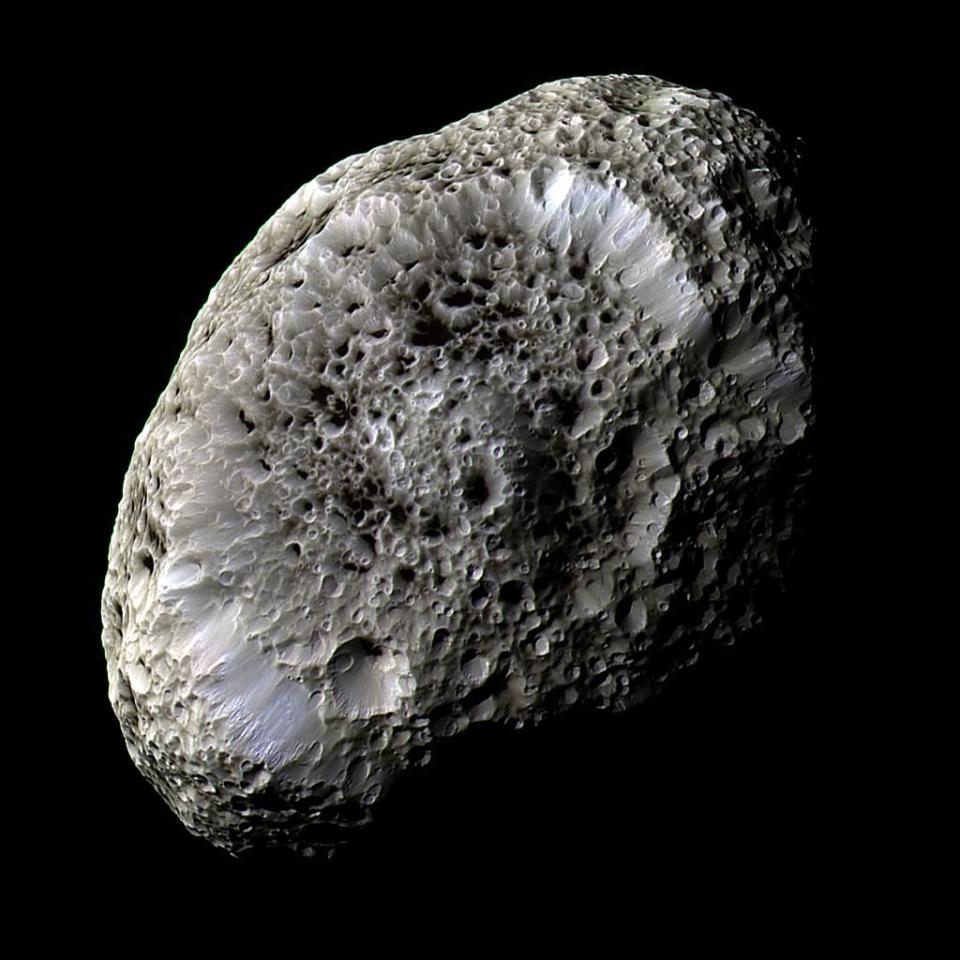
Saturn’s sponge-like Hyperion looks like something you might’ve found in the aisles of Bed Bath & Beyond. The dark spots on Hyperion’s surface, Spilker says, are called sun cups. (These features are similar to snow on Earth, where sullied regions absorb more heat than their lighter counterparts, melt faster, and form indentations.)
It’s not just the spongy appearance that makes Hyperion so fascinating. The moon carries a static charge and actually zapped Cassini with a beam of electrons—the equivalent of a 200-volt charge—as the spacecraft zoomed by in 2005.
22. Thalassa and 23. Naiad

Thalassa and Naiad are stuck together in a never-before-seen “dance of avoidance.” Neptune’s innermost moon, Naiad, has a strange wobbling orbit that shifts in accordance with nearby Thalassa’s orbit. The inner moon’s orbit is tilted by five degrees and bobs up and down in circles around Thalassa’s steady, equatorial orbit.
This cosmic do-si-do stabilizes the moons even though they swing close to each other at their tightest pass—roughly 2,200 miles, or about the driving distance from San Francisco to Chicago. Scientists aren’t sure what kicked off this orbital resonance, but it’s likely some sort of collision
was involved.
Unfortunately, it’s a desperate love story for the two tiny dancers, who have a decaying orbit and will eventually collide with Neptune or form a ring.
24. Janus and 25. Epimethius
The potato-shaped moon Janus is in lockstep with its twin moon Epimetheus. They share the same orbit around Saturn, in a phenomenon called a co-orbital condition. The two moons may have begun their life as a single object, says Spilker.
“They are so big that they cannot physically pass each other,” Spilker says. Epimetheus, the inner moon, goes a bit faster than the outer Janus. In an intricate dance that occurs every four years, “the inner one slowly approaches the outer, and they switch places,” she says.
26. Rhea
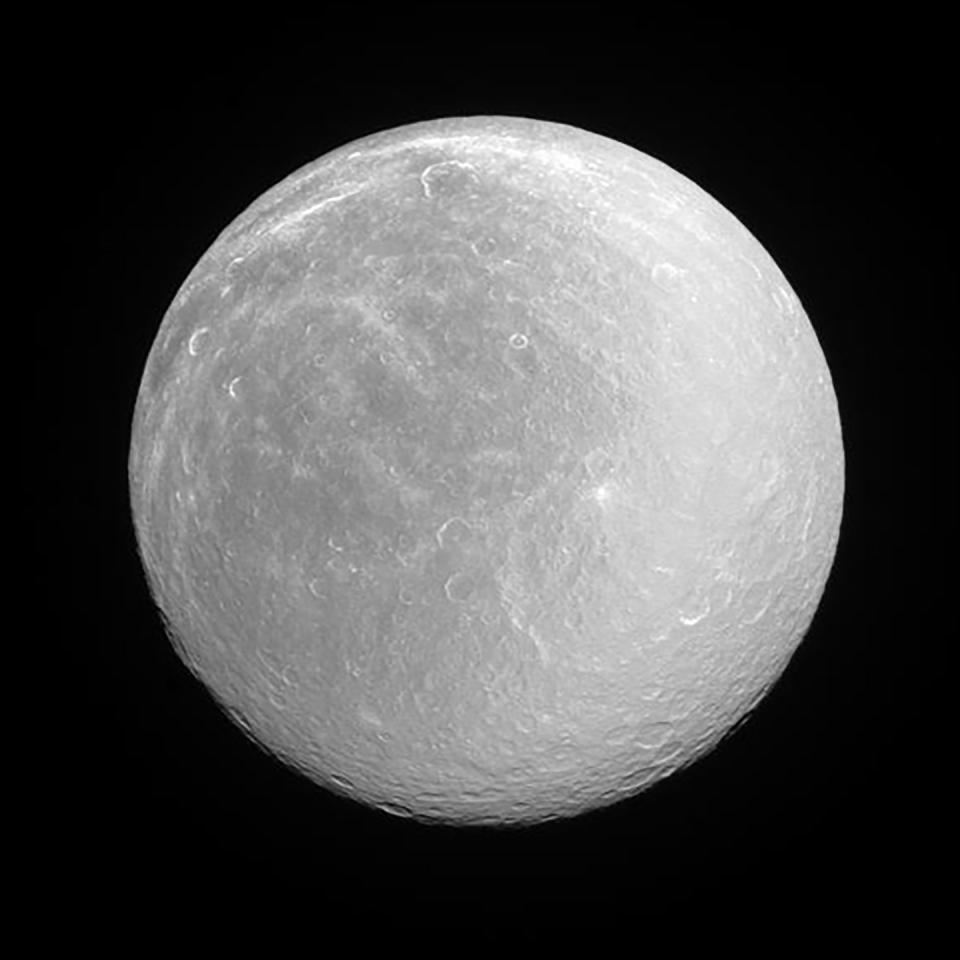
Something strange is happening in orbit around Saturn’s moon Rhea. In 2008, scientists announced they had found evidence that the moon may have a ring of its own—the first discovery of its kind. But because nothing in space is simple, recent research has cast doubt on this theory, and astronomers are now working to figure out what exactly is happening around the curious moon.
27. Amalthea
Jupiter’s moon Amalthea is the reddest object in our solar system, possibly due to sulfur compounds emitted by nearby Io.
28. Hydra
Pluto’s rubber-duck-shaped moon Hydra has a surface covered in large, icy grains.
29. Valetudo
Jupiter’s prograde moon Valetudo lies in a region where most other moons have retrograde orbits. Basically, it’s going the wrong way on a one-way street. Experts say this spells one thing: inevitable collision.
30. Methone
The mile-long Saturnian moon’s smooth body, free of any visible craters or pockmarks, may be made of ultralight ice crystals that act like a liquid. According to a 2013 analysis of Cassini data, it’s the least-dense world we’ve discovered yet.
31. Pandora (Saturn)
32. Phoebe (Saturn)
33. Larissa (Neptune)
34. Hippocamp (Neptune)
35. Dione (Saturn)
36. Nix (Pluto)
37. Ariel (Uranus)
38. Umbriel (Uranus)
39. Titania (Uranus)
40. Oberon (Uranus)
41. Dysnomia (Eris)
42. Prometheus (Saturn)
43. Neso (Neptune)
44. Hi’iaka (Haumea)
45. Namaka (Haumea)
46. Nereid (Neptune)
47. Kale (Jupiter)
48. Styx (Pluto)
49. Kerberos (Pluto)
50. Proteus (Neptune)
51. Aegaeon (Saturn)
52. Helene (Saturn)
53. Polydeuces (Saturn)
54. Telesto (Saturn)
55. Calypso (Saturn)
56. Pallene (Saturn)
57. Anthe (Saturn)
58. Themisto (Jupiter)
59. Carpo (Jupiter)
60. S/2018 J 4 (Jupiter)
61. Mab (Uranus)
62. Cordelia (Uranus)
63. Ophelia (Uranus)
64. Bianca (Uranus)
65. Cressida (Uranus)
66. Desdemona (Uranus)
67. Juliet (Uranus)
68. Portia (Uranus)
69. Rosalind (Uranus)
70. Belinda (Uranus)
71. Puck (Uranus)
72. Cupid (Uranus)
73. Perdita (Uranus)
74. S/2009 S 1 (Saturn)
75. Thebe (Jupiter)
76. Metis (Jupiter)
77. Adrastea (Jupiter)
78. Kiviuq (Saturn)
79. Ijiraq (Saturn)
80. Paaliaq (Saturn)
81. Siarnaq (Saturn)
82. Tarqeq (Saturn)
83. S/2004 S 31 (Saturn)
84. S/2005 S 4 (Saturn)
85. S/2019 S 1 (Saturn)
86. S/2019 S 6 (Saturn)
87. S/2019 S 14 (Saturn)
88. S/2020 S 1 (Saturn)
89. S/2020 S 3 (Saturn)
90. S/2020 S 5 (Saturn)
91. Galatea (Neptune)
92. Despina (Neptune)
93. Halimede (Neptune)
94. Psamathe (Neptune)
95. Laomedeia (Neptune)
96. Sao (Neptune)
97. Carme (Jupiter)
98. Herse (Jupiter)
99. Aitne (Jupiter)
100. Taygete (Jupiter)
101. Chaldene (Jupiter)
102. Erinome (Jupiter)
103. Kallichore (Jupiter)
104. Kalyke (Jupiter)
105. Pasithee (Jupiter)
106. Eukelade (Jupiter)
107. Arche (Jupiter)
108. Isonoe (Jupiter)
109. (Come on,) Eirene (Jupiter)
110. S/2010 J 1 (Jupiter)
111. S/2003 J 19 (Jupiter)
112. S/2017 J 2 (Jupiter)
113. S/2017 J 5 (Jupiter)
114. S/2017 J 8 (Jupiter)
115. S/2011 J 1 (Jupiter)
116. S/2003 J 9 (Jupiter)
117. S/2003 J 10 (Jupiter)
118. S/2003 J 24 (Jupiter)
119. S/2016 J 3 (Jupiter)
120. S/2018 J 3 (Jupiter)
121. S/2021 J 4 (Jupiter)
122. S/2021 J 5 (Jupiter)
123. S/2021 J 6 (Jupiter)
124. S/2022 J 1 (Jupiter)
125. S/2022 J 2 (Jupiter)
126. Skathi (Saturn)
127. Skoll (Saturn)
128. Greip (Saturn)
129. Hyrrokkin (Saturn)
130. Jarnsaxa (Saturn)
131. Mundilfari (Saturn)
132. Bergelmir (Saturn)
133. Narvi (Saturn)
134. Suttungr (Saturn)
135. Hati (Saturn)
136. Farbauti (Saturn)
137. Thrymr (Saturn)
138. Aegir (Saturn)
139. Bestla (Saturn)
140. Fenrir (Saturn)
141. Surtur (Saturn)
142. Kari (Saturn)
143. Ymir (Saturn)
144. Loge (Saturn)
145. Fornjot (Saturn)
146. Gridr (Saturn)
147. Angrboda (Saturn)
148. Skrymir (Saturn)
149. Gerd (Saturn)
150. S/2004 S 26 (Saturn)
151. S/2004 S 34 (Saturn)
152. Eggther (Saturn)
153. Beli (Saturn)
154. Gunnlod (Saturn)
155. Thiazzi (Saturn)
156. Alvaldi (Saturn)
157. Geirrod (Saturn)
158. S/2004 S 7 (Saturn)
159. S/2004 S 12 (Saturn)
160. S/2004 S 13 (Saturn)
161. S/2004 S 17 (Saturn)
162. S/2004 S 21 (Saturn)
163. S/2004 S 28 (Saturn)
164. S/2004 S 36 (Saturn)
165. S/2004 S 37 (Saturn)
166. S/2004 S 39 (Saturn)
167. S/2004 S 40 (Saturn)
168. S/2004 S 41 (Saturn)
169. S/2004 S 42 (Saturn)
170. S/2004 S 43 (Saturn)
171. S/2004 S 44 (Saturn)
172. S/2004 S 45 (Saturn)
173. S/2004 S 46 (Saturn)
174. S/2004 S 47 (Saturn)
175. S/2004 S 48 (Saturn)
176. S/2004 S 49 (Saturn)
177. S/2004 S 50 (Saturn)
178. S/2004 S 51 (Saturn)
179. S/2004 S 52 (Saturn)
180. S/2004 S 53 (Saturn)
181. S/2005 S 5 (Saturn)
182. S/2006 S 1 (Saturn)
183. S/2006 S 3 (Saturn)
184. S/2006 S 9 (Saturn)
185. S/2006 S 10 (Saturn)
186. S/2006 S 11 (Saturn)
187. S/2006 S 13 (Saturn)
188. S/2006 S 14 (Saturn)
189. S/2006 S 15 (Saturn)
190. S/2006 S 16 (Saturn)
191. S/2006 S 17 (Saturn)
192. S/2006 S 18 (Saturn)
193. S/2006 S 19 (Saturn)
194. S/2006 S 20 (Saturn)
195. S/2007 S 2 (Saturn)
196. S/2007 S 3 (Saturn)
197. S/2007 S 5 (Saturn)
198. S/2007 S 6 (Saturn)
199. S/2007 S 7 (Saturn)
200. S/2007 S 9 (Saturn)
201. S/2019 S 2 (Saturn)
202. S/2019 S 3 (Saturn)
203. S/2019 S 4 (Saturn)
204. S/2019 S 5 (Saturn)
205. S/2019 S 7 (Saturn)
206. S/2019 S 8 (Saturn)
207. S/2019 S 9 (Saturn)
208. S/2019 S 10 (Saturn)
209. S/2019 S 11 (Saturn)
210. S/2019 S 12 (Saturn)
211. S/2019 S 13 (Saturn)
212. S/2019 S 15 (Saturn)
213. S/2019 S 16 (Saturn)
214. S/2019 S 17 (Saturn)
215. S/2019 S 18 (Saturn)
216. S/2019 S 19 (Saturn)
217. S/2019 S 20 (Saturn)
218. S/2019 S 21 (Saturn)
219. S/2020 S 2 (Saturn)
220. S/2020 S 6 (Saturn)
221. S/2020 S 7 (Saturn)
222. S/2020 S 8 (Saturn)
223. S/2020 S 9 (Saturn)
224. S/2020 S 10 (Saturn)
225. Ananke (Jupiter)
226. Euanthe (Jupiter)
227. Euporie (Jupiter)
228. Harpalyke (Jupiter)
229. Helike (Jupiter)
230. Hermippe (Jupiter)
231. Iocaste (Jupiter)
232. Mneme (Jupiter)
233. Orthosie (Jupiter)
234. Praxidike (Jupiter)
235. Thelxinoe (Jupiter)
236. Thyone (Jupiter)
237. Eupheme (Jupiter)
238. S/2010 J 2 (Jupiter)
239. S/2016 J 1 (Jupiter)
240. S/2003 J 18 (Jupiter)
241. S/2017 J 3 (Jupiter)
242. S/2017 J 7 (Jupiter)
243. S/2017 J 9 (Jupiter)
244. S/2003 J 2 (Jupiter)
245. S/2003 J 12 (Jupiter)
246. S/2003 J 16 (Jupiter)
247. S/2021 J 1 (Jupiter)
248. S/2021 J 2 (Jupiter)
249. S/2021 J 3 (Jupiter)
250. S/2022 J 3 (Jupiter)
251. Caliban (Uranus)
252. Stephano (Uranus)
253. Margaret (Uranus)
254. Francisco (Uranus)
255. Trinculo (Uranus)
256. Sycorax (Uranus)
257. Prospero (Uranus)
258. Setebos (Uranus)
259. Ferdinand (Uranus)
260. Tarvos (Saturn)
261. Erriapus (Saturn)
262. Albiorix (Saturn)
263. Bebhionn (Saturn)
264. S/2004 S 29 (Saturn)
265. S/2004 S 24 (Saturn)
266. S/2006 S 12 (Saturn)
267. S/2007 S 8 (Saturn)
268. S/2020 S 4 (Saturn)
269. Pasiphae (Jupiter)
270. Sinope (Jupiter)
271. Aoede (Jupiter)
272. Callirrhoe (Jupiter)
273. Eurydome (Jupiter)
274. Kore (Jupiter)
275.Cyllene (Jupiter)
276. Hegemone (Jupiter)
277. Sponde (Jupiter)
278. Autonoe (Jupiter)
279. Megaclite (Jupiter)
280. Philophrosyne (Jupiter)
281. S/2011 J 2 (Jupiter)
282. S/2017 J 1 (Jupiter)
283. S/2017 J 6 (Jupiter)
284. S/2003 J 4 (Jupiter)
285. S/2003 J 23 (Jupiter)
286. S/2016 J 4 (Jupiter)
287. Himalia (Jupiter)
288. Elara (Jupiter)
289. Lysithea (Jupiter)
290. Leda (Jupiter)
291. Ersa (Jupiter)
292. Pandia (Jupiter)
293. Dia (Jupiter)
294. S/2011 J 3 (Jupiter)
295. S/2018 J 2 (Jupiter)
296. S/2023 U 1 (Uranus)
297. S/2002 N 5 (Neptune)
298. S/2021 N 1 (Neptune)
You Might Also Like

 Yahoo News
Yahoo News 
